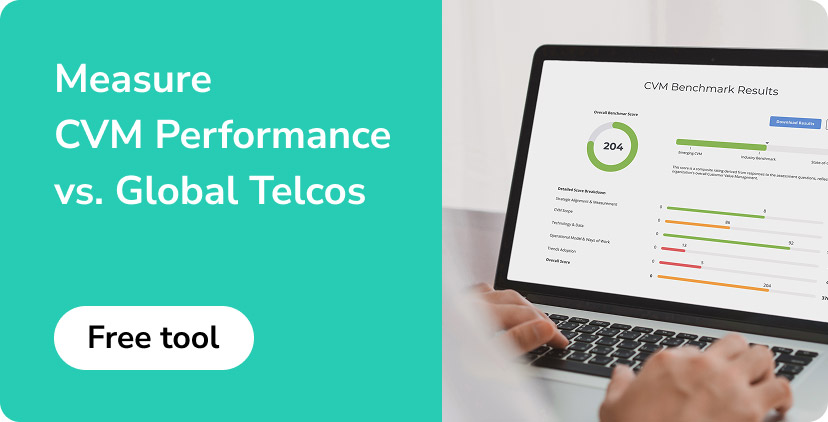How to Build a Prepaid Churn Model in One Day
Churn, or customer turnover between providers, is a major obstacle in nearly every industry. According to the Harvard Business Review, it costs up to 25X as much to find a new customer than to retain an existing one. In other words, take good care of your existing customers!
In our last blog post, we covered how to improve your prepaid retention initiatives and how to reduce prepaid customer churn rate. Now, it’s time to dive deeper. In this post we’ll share how we developed a prepaid churn model, implemented as a Prepaid Churn Prediction App, that you can easily deploy in a fraction of the time.
Telecoms do everything they can with their data to try to retain customers, but building an effective retention model isn’t easy. Some challenges along the way include:
- How to identify a proper algorithm
- Experimenting with different churn definitions
- Defining various features & KPIs crucial for model training
- Testing model performance on different segments
- Ensuring model stability
Typically, the entire process might take weeks to months. But what if it could be done in one day?
Deep Learning is the way to go
Over the last 10 years, Exacaster developed expertise with various machine learning algorithms (Random Forests, XGBoost, etc.), and we gathered deep telco churn prediction know how. Along the way, we discovered that a universal machine learning model could not capture all types of churn, so we built our own advanced Prepaid Retention solution. It’s much more effective as it combines segmentation and models with different prediction criteria.
For example, for “very active” customers, we predicted migration to “less active” segments because this can be a churn equivalent. This approach provided high accuracy for different customer types, however, each new deployment required significant effort, including models retraining, parameters tuning & calibration, features preparation, and other actions to find the best fit. All this complexity pushed us to try something totally new: Deep Learning.
Deep Learning is widely used for complex problems, such as image recognition, object detection, and voice recognition. Our team realized that churn prediction is similar to image detection since the goal is to identify different behavior patterns. In a nutshell, we wanted the model to learn which behavior leads to churn. We were thrilled when the first simple neural network we deployed outperformed all previous approaches! It was clear Deep Learning was the way to go, so we dived in.
Advantages of Switching to a Deep Learning (DL) Model:
- Outperforms other approaches like complex segmentation with separate models per segment.
- Reduces complexity related to hundreds of different features preparation. The model takes only the two most important data sets as input: outgoing activity and recharges.
- Produces nearly calibrated results, representing actual probabilities better than such machine learning algorithms like Random Forest or XGBoost.
- Reduces complexity related to segmentation. Now, the neural network is capable of distinguishing different segments by itself.
- The model is ultra-stable as it’s trained on mixed data from multiple telcos. Therefore, different behaviors can be recognized.
- As a bonus, the model returns probability to churn AND probability to be reached with an offer. You can prioritize retention activities for customers who have a higher probability to be retained.
- High speed deployment.
Prepaid Churn Prediction App
A Deep Learning model is core to the Prepaid Churn Prediction App built-in the Exacaster Customer Data Platform. The app has an easy setup and can bring you results in one day. All it takes is just a few clicks:
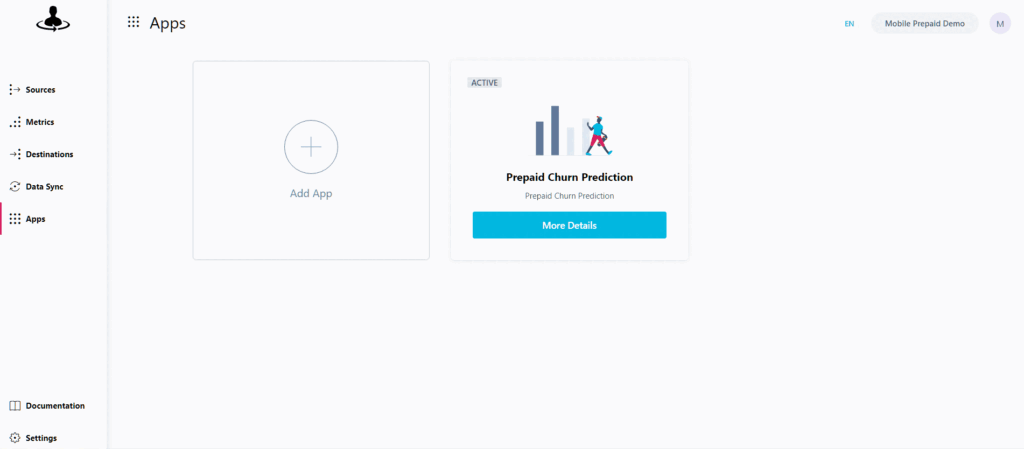
As an input for the model, you need only 3 data sets:
- Recharge events
- Outgoing action events
- Active customers list
Next, you add the data sets and configure a prepaid churn prediction model:
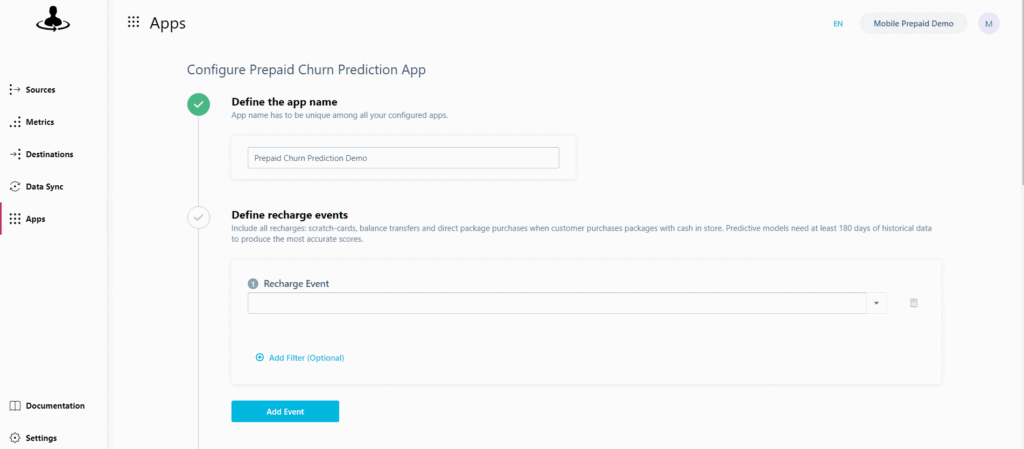
Voila! Your model is running—and it takes less than a day to calculate results.
As output, the prepaid churn model returns 3 main KPI’s per customer:
- Probability to churn – This metric filters out the most risky customers.
- Probability to save – This is the probability to reach a customer with an offer. It optimizes retention costs and targets only customers with a high probability of being reached.
- Activity label – Used to explain how the model determines customer risk and gives information about the type of customer. This KPI reveals: 1) how frequently customer uses service, and 2) what is the current non-usage state – is it normal or does it has deviations from customer’s usage pattern? Here is an example: Pedro usually uses services every 1-2 days, and now he hasn’t used service for 5 days. This is not usual behavior for him. In such a case, the model alerts that there is a high probability to churn and explains in advance that Pedro is a high-frequent user with an increasing non-usage period. That’s how “Activity label” works.
The Exacaster algorithm can learn complex activity patterns and identify churn events at an individual customer level. It enables you to spot churn early by detecting irregularities in customers’ behavior.
In the chart below, you can see how the probability to churn adjusts according to customer behavior:
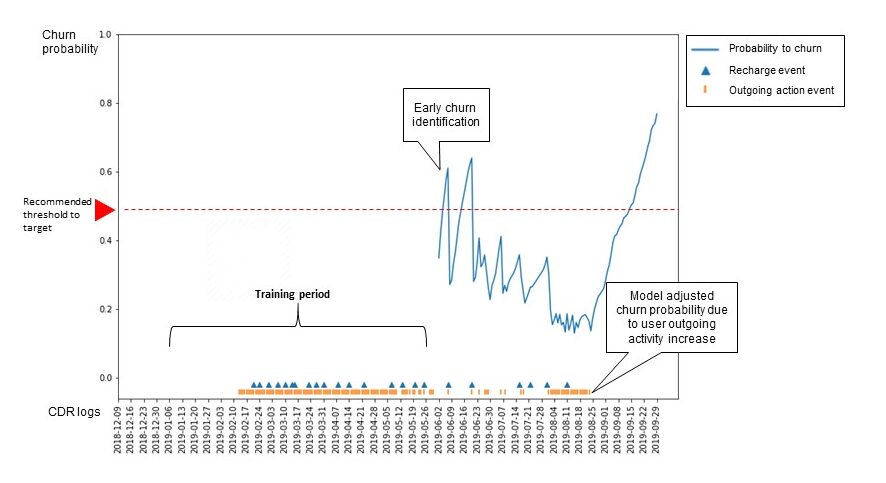
Targeting users based only on an inactivity gap could lead to mistargeting and deteriorate ARPU in the base, especially with irregular service consumption. The Exacaster model avoids mistargeting users who consume more passively. In the chart below, you can see how the model adjusts to irregularities inactivity:
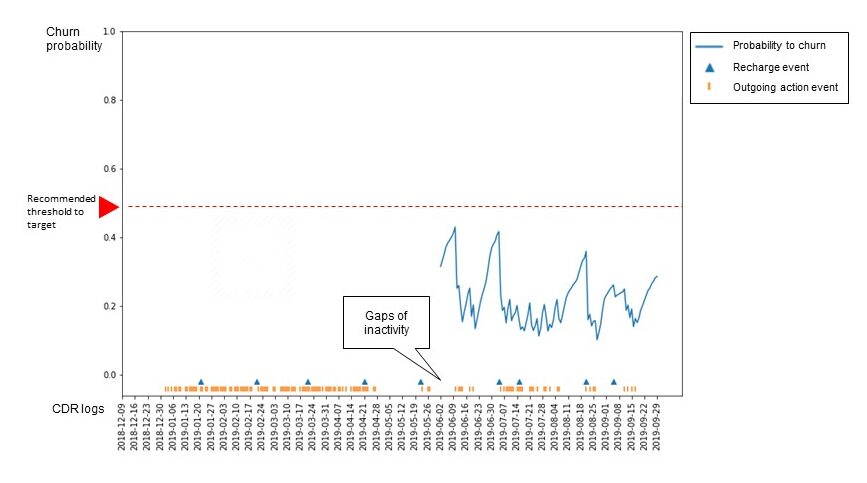
Along with the model’s KPIs, the Prepaid Churn Prediction App provides interactive dashboards. This makes it easy to understand the customer base and guides relevant decision making about which customers should be targeted.
The example below shows how you can select customers by probability to churn and by probability to be reached. This enables you to optimize your retention costs and increase conversion rates by targeting only those that have a good chance to be reached with a retention offer.
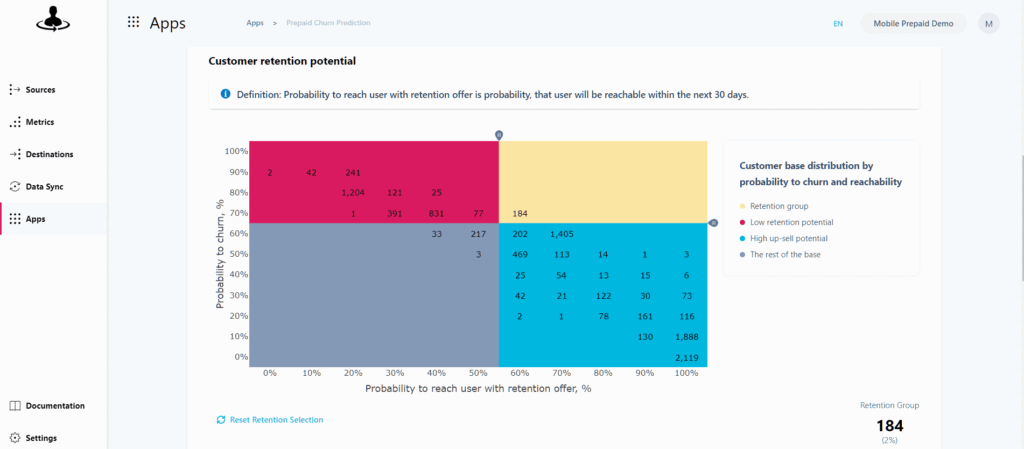
Once the target group is selected, you can estimate the retention campaign incremental revenue potential with our “Retention Campaign ROI calculator”:
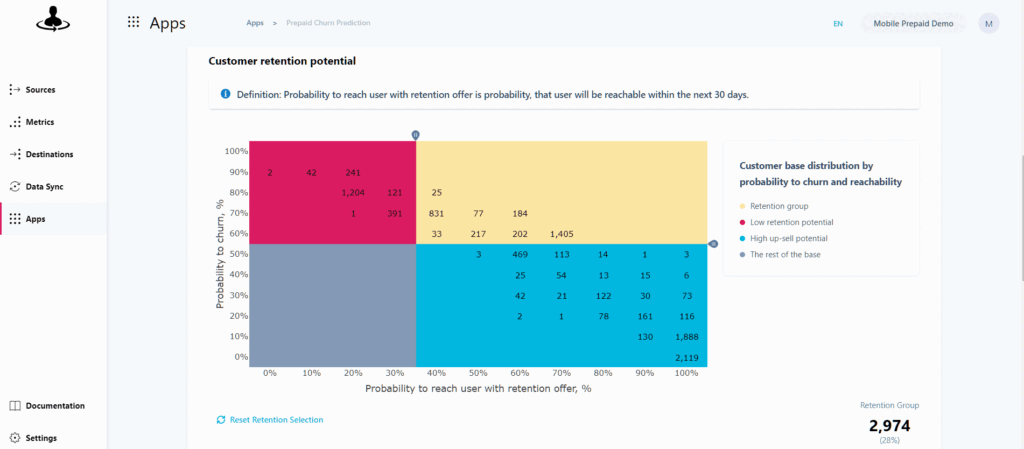
And that’s it! In less than a day you can launch a Prepaid Retention campaign and estimate your return on investment.
Learn more about the Customer Data Platform for Telecoms and book a demo!

Marta Cretu - Data Scientist
Marta Cretu is a Data Scientist at Exacaster. Marta grew together with the company, and she helps serve our biggest clients. Marta build models designed to retain customers for Telco companies. Her deep industry knowledge, analytical capabilities, and science behind the data are critical for developing cutting edge Telecom Customer Data Platforms.
What to read next?
Download whitepaper “Customer Retention For Prepaid Base Management”
- What is a comprehensive value growth framework
- Main challenges to retain prepaid customer
- 5 steps to build an effective retention initiative
- How to keep risky new prepaid subscribers
- Why Customer 360 enables next-generation customer base management



